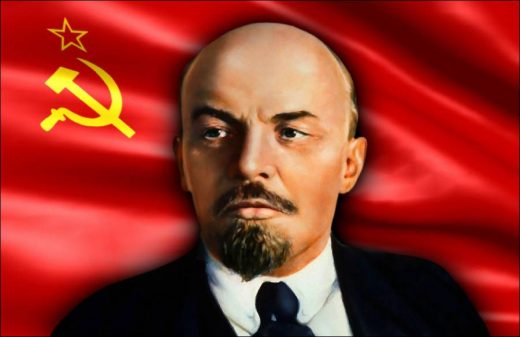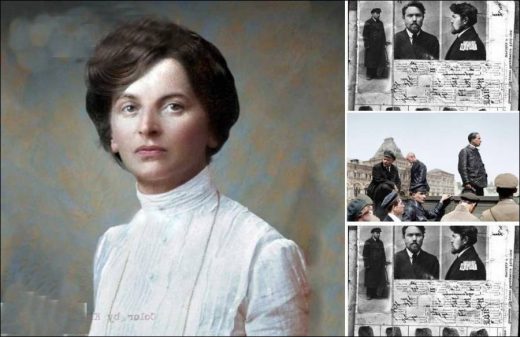What was Lenin doing in France, A group of Russian, Ukrainian and Polish revolutionary youth, besieged by a oppressive regime that does not allow the slightest democratic space to live, a stagnant urban life, cultural backwardness and religious bigotry, took the risk of an incredible adventure and met with the most advanced elements of their parties in France. prepared for a revolutionary program. They were attached to each other.
The year 1911 had been a harsh and strange winter. The new year opened with the Premiere of Richard Strauss’s Pink Knight at the Dresden Opera house, and everyone was stunned by the first-ever plane-launched bomb in the war between Italian and Ottoman forces.
France’s conversion of Morocco into a protectorate at the expense of Germany would cause international tension. The famous Mona Lisa painting, stolen from the Louvre Museum in Paris in August, was the main agenda item of European society throughout the year, while the painting would only reappear in 1913. Although it was not noticed at first glance, it was as if all the stones in the world were moving.
In the same year, the world of Russian revolutionaries was also bubbling. The heavy defeat of the working class in Russia in 1905 not only dispersed the positions that the working class had won and strengthened the reactionary monarchies of Europe. Defeat also meant for the vast majority of the pioneers involved in the Russian Social Democratic Labor Party (RSDIP) to be once again driven into Europe on a massive scale, into exile, intimidation, into that gray vortex.

Hard times
On the other hand, the revolutionary vanguards, who bore the burden of organizing, inciting and propagating the urban masses in Russia, were now disillusioned with the underground life. They either went abroad through illegal immigration, retired from revolutionary activity, or ended up in tsarist prisons. This meant only one thing; The tasks of directing and organizing the workers’ movement now had to be undertaken by the workers themselves, who lacked the practical experience of revolutionary activity and surviving underground conditions.
Those were tough times. Reunited in 1906 by pressure from the workers’ base, the RSDLP was again in the grip of a perpetual crisis caused by a terrible war between the factions. Aside from the growing tension of Bolshevik and Menshevik tendencies, the state of defeat and intimidation opened up enormous space in the Party for any sectarian or skeptical tendencies.
Deists
Among the main actors of the debate in the ranks of the party, the section called “Liquidators” by Lenin and sneering at all kinds of underground activities, on the contrary, the “Otzovists” who proposed to withdraw completely from parliamentary activity in the elections and Duma, saying that the only indicator of revolutionism in the opposite lane was “disorder”. and even among the emotional shocks and deep disappointments are the “Deists” who propose to reach the working class through a link between Marxism and religion.
However, by 1911, the Russian working class gradually began to show its teeth to the tsarist autocracy. This new wave of workers’ mobilizations would have the effect of fresh blood pumped through the veins for Lenin.
The idea of organizing a Marxist underground party school in the village of Longjumeau, with a population of 2,440, near Paris, away from both the poison spies of the tsarist secret service and the eyes of the French police, came from young party workers who came to the fore in the struggle in Russia. It was the goal of a group being trained in a rigorous Marxist method.
17 Students
Lenin intended to rebuild the party on methodological grounds and on these young vanguards. A fusing, rigorous Marxist summer school to be held on the revolutionary tasks of the new era with the representatives of the new generations of struggle…
This initiative could both reinforce the Bolshevik trend and serve to attract the young workers and student leaders who led the new mobilizations in Russia to a revolutionary program. Moreover, if the participation of educators who did not come from Bolshevik but had revolutionary tendencies could be provided, this school could act as a lever.
The news was conveyed to the Russian party organization, which was completely underground under the pressure of the Tsarist, for the designed “Party School”. 17 students were selected immediately by 9 local units, which try to operate under confidentiality conditions.
These 17 students were expected to reach Paris on a mind-bogglingly adventurous route with 150 francs each in their pockets and fake passports. Exit routes were mostly passing through forests on the border line of Poland, Finland and Sweden. Finally, the destination was reached by train from Germany. Some participants were able to cover the port of Marseille with a grueling cruise over the Black Sea.
A carpenter’s workshop was rented for two months in the village of Longjumeau for the party school, the preparations of which began in the spring of 1911. The main hall of the workshop was to be used for common lessons, and its 5 rooms were to be used for the accommodation of prospective students who would infiltrate into France through adventurous ways.
17 students attended the school. The ages of the participants ranged from 18 to 25. Except for a few students, most of those selected were heavy industry workers. While 11 revolutionaries were from the Bolshevik trend of the party, 1 of them was Otzovist[2] and 5 of them were from the Menshevik trend. It turned out that the two Menshevik-leaning participants had been men of the Okhrana, the tsarist secret service, from the very beginning. So the counter-revolution had managed to infiltrate this special training work from the very beginning.
As for the instructors of the Party School; all of them consisted of Russians abroad. Some were of Bolshevik inclination, some were not. But all those who, having accepted the post of instructor, were meticulously on the preparatory committee for months, were openly comrades eager to cooperate with Lenin on his “project”.
Vladimir Ilyich Lenin was to become the main instructor of the school. Nadezhda Krupskaya took responsibility for the conditions of secret entry and exit abroad. As for Inessa Armand, she was everything about school; All the technical infrastructure, texts, excursions, solving the problems between the students all depended on his skill.
Other instructors included Zinoviev, Kamanev, Semachko, Lunatcharski and Volski, who were then in the Otzovist ranks, and Riazanov and Steklov.
How did the Longjumeau Party School work?
Instructors were making their morning presentations, and following the lunch, the participants focused on a selected set of topics. Materials on questions and possibilities were prepared on the topics of focus.
The participants were discussing how attitudes could be taken in line with Marxist methodology in the face of the possibilities addressed with their questions and presentations. Undoubtedly, Lenin was in the position of the principal trainer of the school, with 29 presentations on political economy – it lasted 43 hours – 12 presentations on the agrarian question – lasted 18 hours – 12 presentations of history and socialism experiences, and finally 3 presentations of history and materialism, which he undertook due to Plekhanov’s absence. His presentations were carefully prepared and very disciplined.
In a presentation where the problems of the program were discussed, he asked the young participants, “Assume for a moment that we have taken power, what would you do to the banks? he had asked a question. As one participant shyly recalled, the correct answer was not “we must destroy them”.
As for other educators, they shared topics such as the history of the Russian party, the history of the western working class, the law and the working class, literature, revolutionary publishing techniques. In addition, the seminars taught students the techniques of writing political texts, public speaking methods, and managing party correspondence.
On the other hand, art was not forgotten in the Party school. Various workshops were held in this area, and the revolutionary participants of the school went to Paris twice under the leadership of Anatoli Lunatcharski and had the opportunity to visit the Louvre Museum and the historical sites of the French revolution under his guidance.
That summer at Longjumeau wasn’t all about class. Lenin insisted that no work be done on Sundays, and he often organized cycling trips for students or walks in the Parisian countryside. One of the most popular excursions was the 12-kilometer bike ride to the Sein River for an afternoon swim on the weekends.
These trips were also a unique experience for the young revolutionaries who got to know their leaders for the first time. They met not a chess addict, tough and cold man, but a relaxed and deep person who loved to walk, often joked and sang Russian folk songs.
In the summer of 1911, something mind-blowing was accomplished in that small Parisian village. A group of Russian, Ukrainian and Polish revolutionary youth, besieged by a oppressive regime that does not allow the slightest democratic space to live, a stagnant urban life, cultural backwardness and religious bigotry, took the risk of an incredible adventure and met with the most advanced elements of their parties in France. won a revolutionary program. They were attached to each other.
Their new goal was to convince the Russian proletariat that it “had to manage its own destiny, be democratic and take power with a revolution at the head of the toiling masses”. The future of the Bolsheviks was now secure.
Students in Paris
The first to reach Paris were St. It was three students from St. Petersburg; Bielostotzki, Vladimir and Georges. They were followed by Vera Vasilieva, a female textile worker of the VPeriod trend. Viasilieva would become the school’s only female student. Two more workers arrived from Moscow within a few days; Prissiaguine was a tannery worker, the other comrade, whose name is unknown, a textile worker. They were followed by workers Andreev, who had come a long way from Nikolaev, Sema (Semko) and Dogadov from Baku, and Andre Malinovski and Tchougourne, elected from Kiev, both of Menshevik leanings. Finally, Savya (Sevine), Vassili and the last members of the team, Oleg and Mantzev from Poland, arrived in Paris.
[2] Otzovist; A term derived from the Russian verb “to recall”, describing a group that emerged in 1908 as a result of disagreement among Bolsheviks. Led by Aleksandr Bogdanov, the group advocated abandoning open possibilities and recalling deputies from the Duma.
Visits: 973



